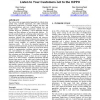Free Online Productivity Tools
i2Speak
i2Symbol
i2OCR
iTex2Img
iWeb2Print
iWeb2Shot
i2Type
iPdf2Split
iPdf2Merge
i2Bopomofo
i2Arabic
i2Style
i2Image
i2PDF
iLatex2Rtf
Sci2ools
KDD
2007
ACM
2007
ACM
Practical guide to controlled experiments on the web: listen to your customers not to the hippo
The web provides an unprecedented opportunity to evaluate ideas quickly using controlled experiments, also called randomized experiments (single-factor or factorial designs), A/B tests (and their generalizations), split tests, Control/Treatment tests, and parallel flights. Controlled experiments embody the best scientific design for establishing a causal relationship between changes and their influence on user-observable behavior. We provide a practical guide to conducting online experiments, where end-users can help guide the development of features. Our experience indicates that significant learning and return-oninvestment (ROI) are seen when development teams listen to their customers, not to the Highest Paid Person's Opinion (HiPPO). We provide several examples of controlled experiments with surprising results. We review the important ingredients of running controlled experiments, and discuss their limitations (both technical and organizational). We focus on several areas tha...
Data Mining | Data Mining Techniques | Descriptors G.3 Probability | Extensive Practical Experience | KDD 2007 |
| Added | 30 Nov 2009 |
| Updated | 30 Nov 2009 |
| Type | Conference |
| Year | 2007 |
| Where | KDD |
| Authors | Ron Kohavi, Randal M. Henne, Dan Sommerfield |
Comments (0)

